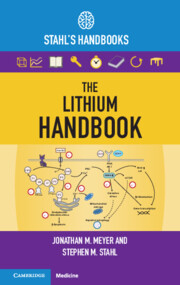Book contents
- The Lithium Handbook
- Reviews
- The Lithium Handbook
- Copyright page
- Contents
- Foreword
- Preface: How to Use This Handbook
- Introduction
- 1 The Efficacy Story
- 2 Renal Handling of Lithium
- 3 Clinical Pharmacokinetics
- 4 Lithium Initiation and Monitoring
- 5 Management of Routine Lithium Related Adverse Effects
- 6 Lithium Toxicity
- 7 Special Populations and Circumstances
- 8 Lithium Discontinuation
- Index
- References
4 - Lithium Initiation and Monitoring
Baseline Assessment; Loading and Initiation Methods; Target Serum Levels; Monitoring Intrinsic Renal Function with New eGFRcr-cys Formula; Office and Laboratory Methods for Monitoring Polyuria; Monitoring Thyroid and Parathyroid Function
Published online by Cambridge University Press: 09 February 2024
- The Lithium Handbook
- Reviews
- The Lithium Handbook
- Copyright page
- Contents
- Foreword
- Preface: How to Use This Handbook
- Introduction
- 1 The Efficacy Story
- 2 Renal Handling of Lithium
- 3 Clinical Pharmacokinetics
- 4 Lithium Initiation and Monitoring
- 5 Management of Routine Lithium Related Adverse Effects
- 6 Lithium Toxicity
- 7 Special Populations and Circumstances
- 8 Lithium Discontinuation
- Index
- References
Summary
While the literature abundantly documents lithium’s unique efficacy profile and the limitations of non-lithium therapies, starting a patient on lithium requires the complete array of one’s clinical skills. One core ability relates to appropriate pharmacological use of lithium, including dosing, level monitoring, and management of drug interactions and adverse effects that lead to discontinuation [1]; however, it is facility in communicating with patients and eliciting their illness beliefs, their ideas about the need for any treatment, and their specific thoughts about lithium therapy that is crucial to minimizing nonadherence [2].
- Type
- Chapter
- Information
- The Lithium HandbookStahl's Handbooks, pp. 203 - 250Publisher: Cambridge University PressPrint publication year: 2023

